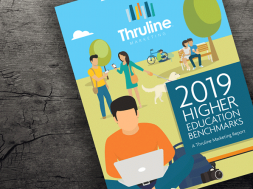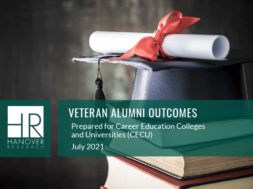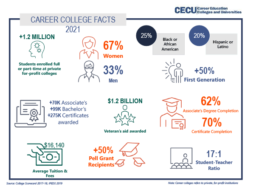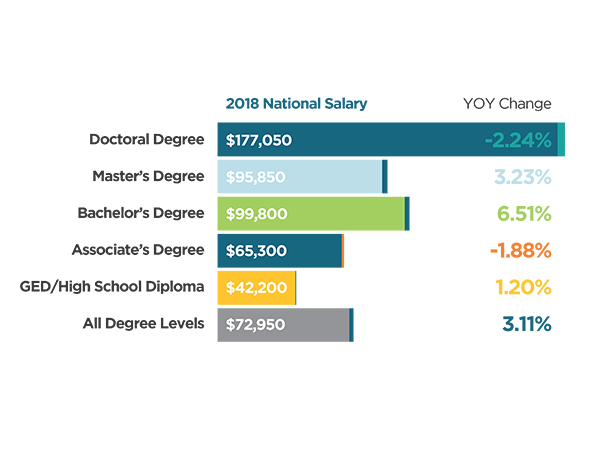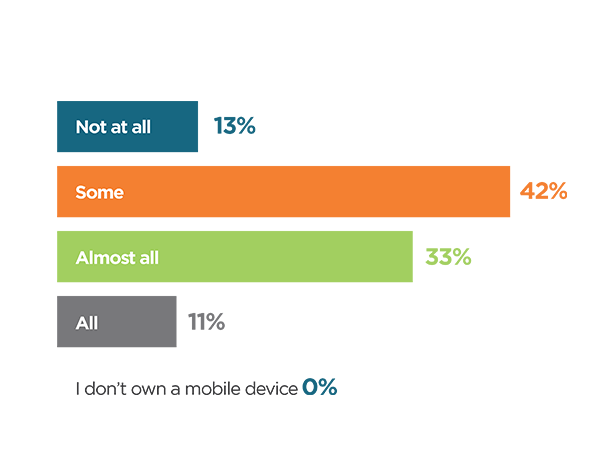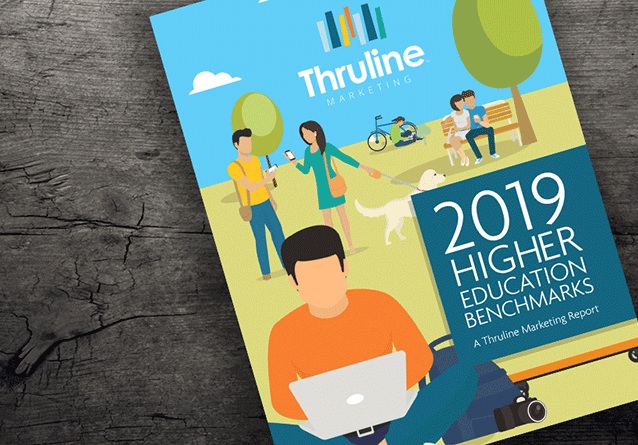
2019 State of the Sector Update
By Tracy Kreikemeier, Chief Marketing Officer, Thruline Marketing
Change is our constant, the rapid pace of change and evolution of both the education market as well as within marketing continues. We recently released our 2019 Higher Education Benchmarks whitepaper, and over the course of developing the report, we had the opportunity to reflect upon all of the changes, education dynamics and media environment that shaped 2018.
Overall, within the education space, 2018 can be summarized as a year of “less worse.”
We continued to see strong pressures and challenges regarding enrollment numbers but also saw a lot of change and advancement around the idea of education. The connection between education and employment was really driven home and the strength of the U.S. economy had a major impact on education institutions. Reports indicate that we can expect a slight growth in enrollment over the next few years. But, with strong competition in the space, it is going to be crucial for educational institutions to take note of the value they can add not only to the current environment but to their prospective students.
What is the value of a degree?
As we talk about how the educational space has recently changed, the value of a degree continues to be under attack both in terms of cost and its importance given the current hiring desperation of employers. Unemployment rates continue to drop and are currently at record lows, yet we are still seeing many people in the job market that are underemployed or unable to secure a job due to a lack of skills. Many of these unfulfilled jobs are falling in the construction, food services, health care, retail and durable goods manufacturing industries. Employers continue to struggle to find qualified workers and are becoming desperate to hire employees to serve their current customer base. So much so, that some employers are offering tuition reimbursement and guaranteed jobs upon graduation through programs.
Unemployment Rate Changes by Educational Attainment
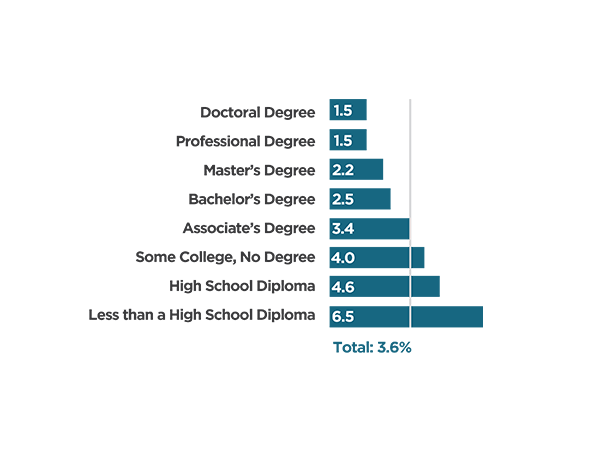
Median National Salary Outcomes by Degree Level
Source: Gartner TalentNeuron, January 2017-October 2017 vs. January 2018-October 2018
We are also continuing to see an increase in online programs offered and enrollment rates are not keeping up. From 2013 to 2017 we saw a 30 percent increase in online programs and only a 20 percent growth rate of online students (Source: Ipeds). While there has been a pretty steady decline in the number of enrollments for for-profit education institutions, what we have been surprised by is that it has not translated into gains in students on the not-for-profit side. A lot of these dislocated students have somewhat disappeared from the enrollment marketplace instead of shifting and moving, and we have seen a new cohort appear on the not-for-profit side.
All of this turmoil leads to the realization that education has evolved into a life-long journey and where your education begins is not the same place it ends. Even if some are lucky enough to keep one particular job, inevitably they will need some sort of training to keep them competitive and at the top of their game throughout their career.
“Over 45 percent of employed adults report they have pursued extra training to maintain or improve their job skills in the past year.”
Over 45 percent of employed adults report they have pursued extra training to maintain or improve their job skills in the past year and the majority of American workers say they will need continuous training to keep up with changes in the workplace (Source: The state of American Jobs’ Pew Research Center). Data also shows that not only is job security higher for those with a degree, so is their expected income.
We are seeing a new environment emerge, one which is driving innovation in competency-based education, alternative tuition models and closer alignment generally between employers and education institutions. Long story short, having a college degree still matters and it is important for institutions to not only be aware of the marginal value of that degree for the learner but that the value aligns with the cost of the degree program and also its relative career opportunities.
It all begins with mobile
This year marks an inflection point where mobile marketing has gone from a growth area to a dominant channel of marketing with mobile surpassing TV ad spending by more than $6 billion (according to our latest ad spending forecast). By 2020, the channel will represent 43 percent of total media spending in the U.S. – a greater percentage than all traditional media combined. (Source: Emarketer September 2018)

A few key points to keep in mind when implementing or revisiting your mobile marketing strategy:
- Site speed is critical for success
- Early morning (7 a.m.-10 a.m.) and Prime (8 p.m.-12 a.m.) are the most impactful when it comes to mobile searching (Source: Digital Future in Focus report from comScore 2018)
- Whether it is targeted ads in search or social media advertising, it is imperative that you are investing in mobile marketing. Over 86 percent of research about schools to attend is conducted on a mobile device, so if you are not creating content that is relevant, engaging and easy to consume on a mobile device, you are missing the mark.
Extent of research about schools to attend conducted on a mobile device (smartphone or tablet but not a laptop)
The student journey is long and intertwined
Making sure you are reaching your prospective students via the right medium is an important start but understanding how to connect with them along their journey is also critical. The landscape is changing and there is almost a $400 million dollar decline in the annual amount of spending by schools putting out the message that education is valuable. That means that the overall amount of noise that consumers hear around the value prop of education is continuing to decline which makes when, how and how often you connect with prospective students even more impactful. The student journey to choosing a school is long and intertwined and there are many touch points along the way.
Several actions are taken before a form is ever filled out that impact the outcome of one’s search, and typically a student will have seen multiple ads, videos and school’s websites before ever filling out a form.
It is important to provide consistent, easy to digest content at each touch point along the way to make sure prospective students understand the value of your institution and how your institution is going to best prepare them for the job outcome they are looking for. We know that the main reason people are going back to school is to get a job or further their career, so it is important to offer programs aligned with relevant job opportunities that will allow your students to accomplish their goals.
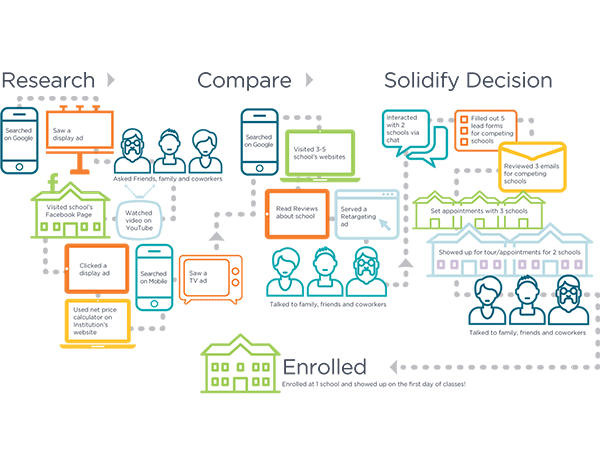
Texting is the preferred form of communication
SMS messaging is one form of communication that we have seen have a major impact on inquiry volume and contact rates. According to Adobe, 98 percent of texts are opened compared to only 20-30 percent for email and has an average 450-750 percent higher engagement rate than email. In addition, reaching millennials without incorporating a texting strategy has proven difficult. Millennials prefer communication that is quick, easy and can largely be done at their convenience. Not to mention they like to minimize the option for conflict which can be easily accomplished through text and chatbots. Connecting with students directly using preferred methods of communication is essential. We have seen immense success with our clients when adding a texting component to a campaign. As you can see below, one of our recent campaigns saw a 300 percent increase in inquiries after adding texting to a campaign. If you are not already utilizing text as a form of communication, now is the time to start.
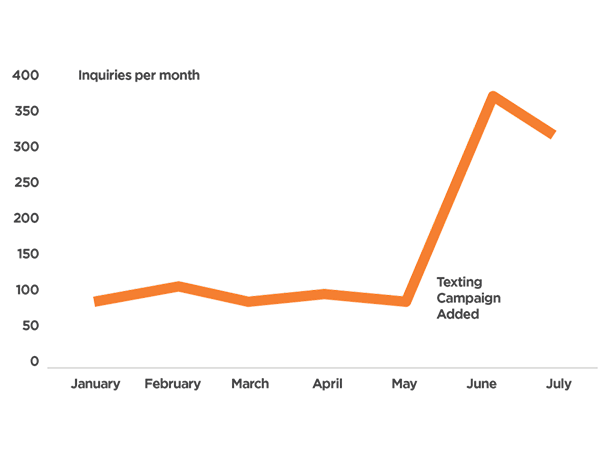
Takeaways
ll in all, the education landscape is changing in many ways and it is important to keep up with how your school fits in and can add value to the current environment. Schools continue to have fierce competition for students and have to reinforce the value of a degree and differentiate their institution. A degree is absolutely still valuable and especially critical for those looking to further their career, which is still the number one reason for continuing education. In addition, currently, 63 percent of all unfilled positions require a degree (Source: CEB TalentNeuron Wanted Analytics). Degree areas matter and show substantial differences in enrollment trends resulting in increased investment in program viability research and job market analytics research. The digital marketing environment is becoming more complex as communication methods are evolving and social media giants compete with Google search for advertising dollars and user engagement.
The net effect of all of this is a continued push for marketers to become more sophisticated, diverse in their channel strategy, and clearly define the value prop of their education institution to attract the right prospective students.
For more detail on the trends we are anticipating for the upcoming year, check out our 2019 Higher Education Benchmarks Report – https://www.thru-line.com/2019-higher-education-benchmarks/
TRACY KREIKEMEIER , Chief Marketing Officer, has been working in postsecondary education for almost 19 years. As CMO, she is responsible for customer acquisition and retention, overseeing key customer relationships, marketing communications and thought leadership for the organization. Her knowledge of the education industry and dedication to partners are unsurpassed among her peers. Tracy faces challenges head-on and encourages others to execute bold strategies and produce their best work. She is a speaker at various industry conventions.
Contact Information: Tracy Kreikemeier // Chief Marketing Officer // Thruline Marketing // 913-254-6015 // Tracy.kreikemeier@thru-line.com // Thru-line.com // LinkedIn: https://www.linkedin.com/company/27245526/admin/ // https://www.linkedin.com/in/tracy-kreikemeier-a734832/ // Instagram: https://www.instagram.com/thrulinemarketing/ // Facebook: https://www.facebook.com/ThrulineMarketing/ // Twitter: https://twitter.com/Thru_line
